FIAT 500L 2015 2.G Owner's Guide
Manufacturer: FIAT, Model Year: 2015, Model line: 500L, Model: FIAT 500L 2015 2.GPages: 148, PDF Size: 3.77 MB
Page 31 of 148

ELECTRONIC SPEED CONTROL
The Electronic Speed Control switches are located on the steering wheel.
Cruise ON/OFF
•Push the ON/OFF button to activate the
Speed Control.
CRUISE READY will appear on the instru-
ment cluster to indicate the Speed Control
is on.
•Push the ON/OFF button a second time
to turn the system off.
•Speed Control will be disabled if the
front tires lose traction.To restore, push
the Cruise ON/OFF button.
Set
•With the Speed Control on, push and
release the SET – button to set a de-
sired speed.
Accel/Decel
To Increase Speed
When the Electronic Speed Control is set, you can increase speed by pushing the RES+
button.
The drivers preferred units can be selected through the instrument panel settings if
equipped.The speed increment shown is dependant on the chosen speed unit of U.S.
(MPH) or Metric (km/h):
U.S. Speed (MPH)
•Pushing the RES+button once will result in a 1 MPH increase in set speed.Each sub-
sequent tap of the button results in an increase of 1 MPH.
•If the button is continually pushed, the set speed will continue to increase until the
button is released, then the new set speed will be established.
Metric Speed (km/h)
•Pushing the RES+button once will result in a 1 km/h increase in set speed.Each sub-
sequent tap of the button results in an increase of 1 km/h.
•If the button is continually pushed, the set speed will continue to increase until the
button is released, then the new set speed will be established.
Electronic Speed Control Switches
1 — Push Resume/Accel2 — Push ON/OFF3 — Push Set/Decel4 — Push Cancel
OPERATING YOUR VEHICLE
29
Page 32 of 148
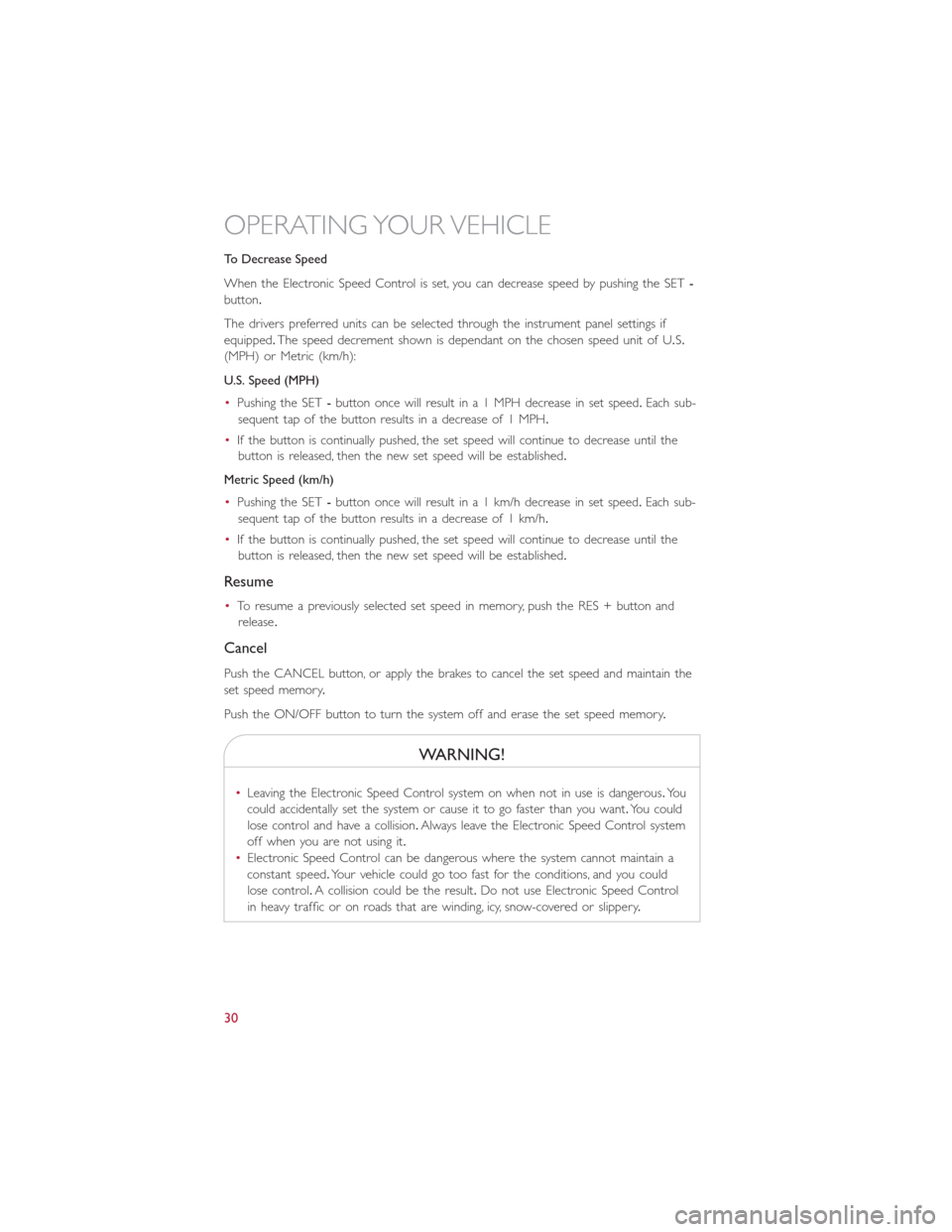
To Decrease Speed
When the Electronic Speed Control is set, you can decrease speed by pushing the SET-
button.
The drivers preferred units can be selected through the instrument panel settings if
equipped.The speed decrement shown is dependant on the chosen speed unit of U.S.
(MPH) or Metric (km/h):
U.S. Speed (MPH)
•Pushing the SET-button once will result in a 1 MPH decrease in set speed.Each sub-
sequent tap of the button results in a decrease of 1 MPH.
•If the button is continually pushed, the set speed will continue to decrease until the
button is released, then the new set speed will be established.
Metric Speed (km/h)
•Pushing the SET-button once will result in a 1 km/h decrease in set speed.Each sub-
sequent tap of the button results in a decrease of 1 km/h.
•If the button is continually pushed, the set speed will continue to decrease until the
button is released, then the new set speed will be established.
Resume
•To resume a previously selected set speed in memory, push the RES + button and
release.
Cancel
Push the CANCEL button, or apply the brakes to cancel the set speed and maintain the
set speed memory.
Push the ON/OFF button to turn the system off and erase the set speed memory.
WARNING!
•Leaving the Electronic Speed Control system on when not in use is dangerous.You
could accidentally set the system or cause it to go faster than you want.You could
lose control and have a collision.Always leave the Electronic Speed Control system
off when you are not using it.
•Electronic Speed Control can be dangerous where the system cannot maintain a
constant speed.Your vehicle could go too fast for the conditions, and you could
lose control.A collision could be the result.Do not use Electronic Speed Control
in heavy traffic or on roads that are winding, icy, snow-covered or slippery.
OPERATING YOUR VEHICLE
30
Page 33 of 148
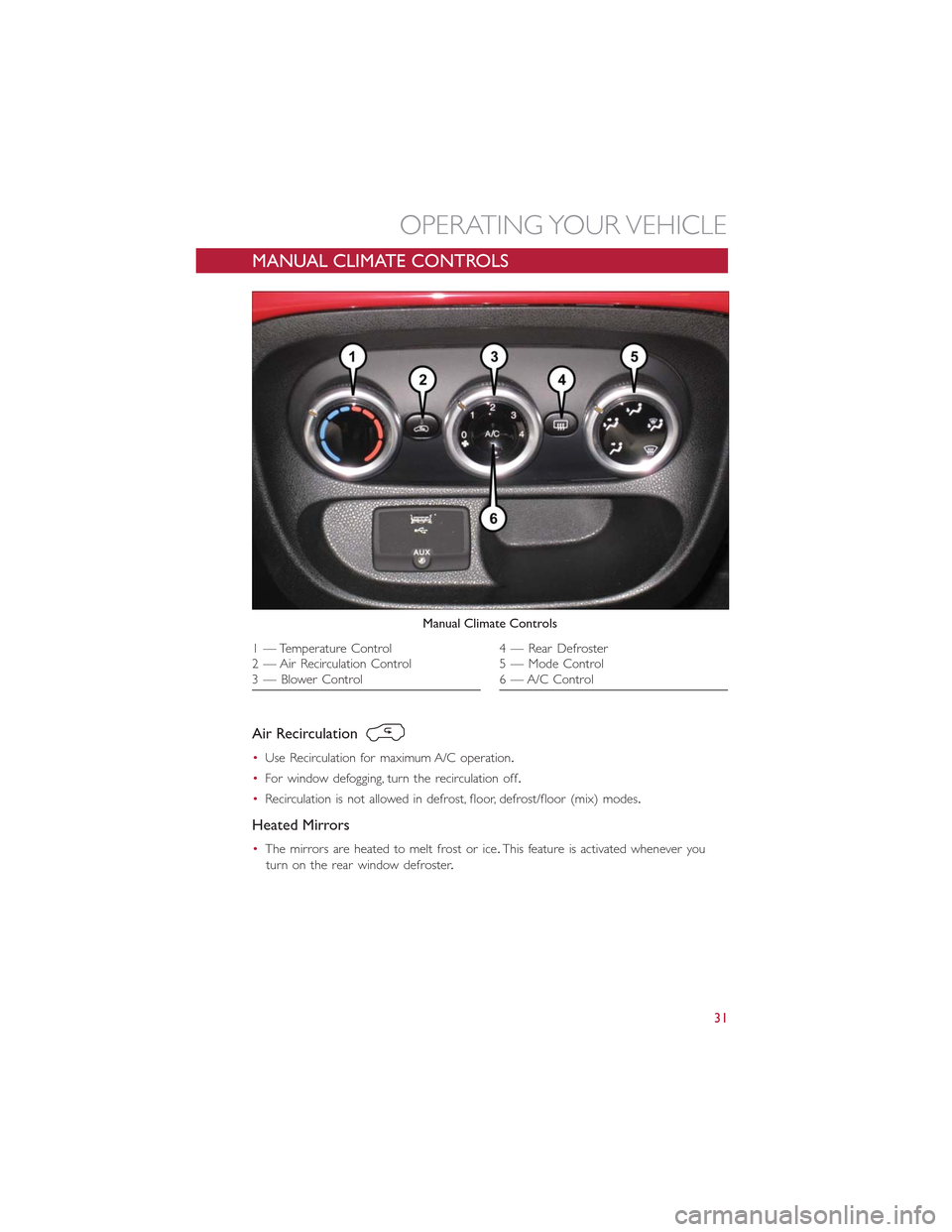
MANUAL CLIMATE CONTROLS
Air Recirculation
•Use Recirculation for maximum A/C operation.
•For window defogging, turn the recirculation off.
•Recirculation is not allowed in defrost, floor, defrost/floor (mix) modes.
Heated Mirrors
•The mirrors are heated to melt frost or ice.This feature is activated whenever you
turn on the rear window defroster.
Manual Climate Controls
1 — Temperature Control2 — Air Recirculation Control3 — Blower Control
4 — Rear Defroster5 — Mode Control6 — A/C Control
OPERATING YOUR VEHICLE
31
Page 34 of 148
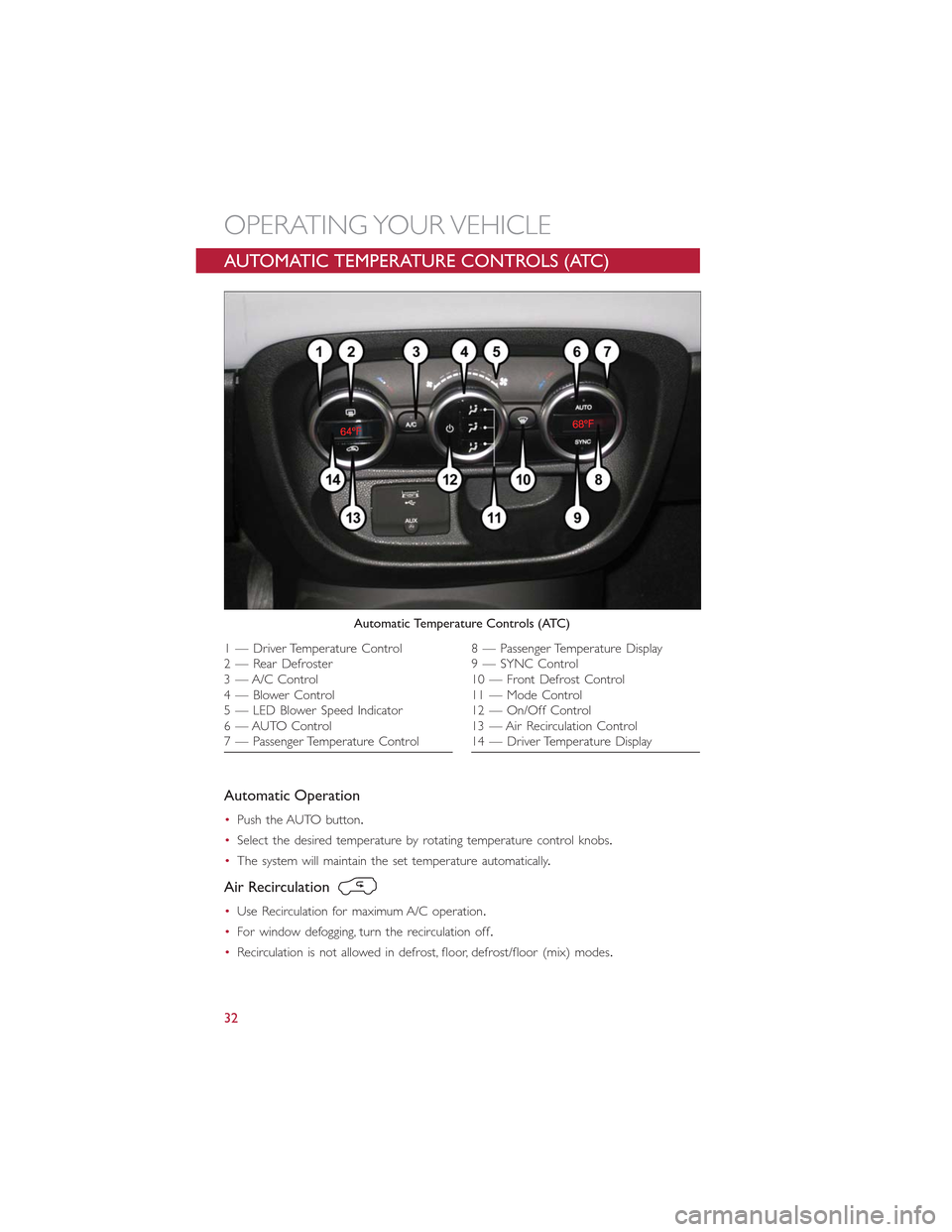
AUTOMATIC TEMPERATURE CONTROLS (ATC)
Automatic Operation
•Push the AUTO button.
•Select the desired temperature by rotating temperature control knobs.
•The system will maintain the set temperature automatically.
Air Recirculation
•Use Recirculation for maximum A/C operation.
•For window defogging, turn the recirculation off.
•Recirculation is not allowed in defrost, floor, defrost/floor (mix) modes.
Automatic Temperature Controls (ATC)
1 — Driver Temperature Control2 — Rear Defroster3 — A/C Control4 — Blower Control5 — LED Blower Speed Indicator6 — AUTO Control7 — Passenger Temperature Control
8 — Passenger Temperature Display9 — SYNC Control10 — Front Defrost Control11 — Mode Control12 — On/Off Control13 — Air Recirculation Control14 — Driver Temperature Display
OPERATING YOUR VEHICLE
32
Page 35 of 148
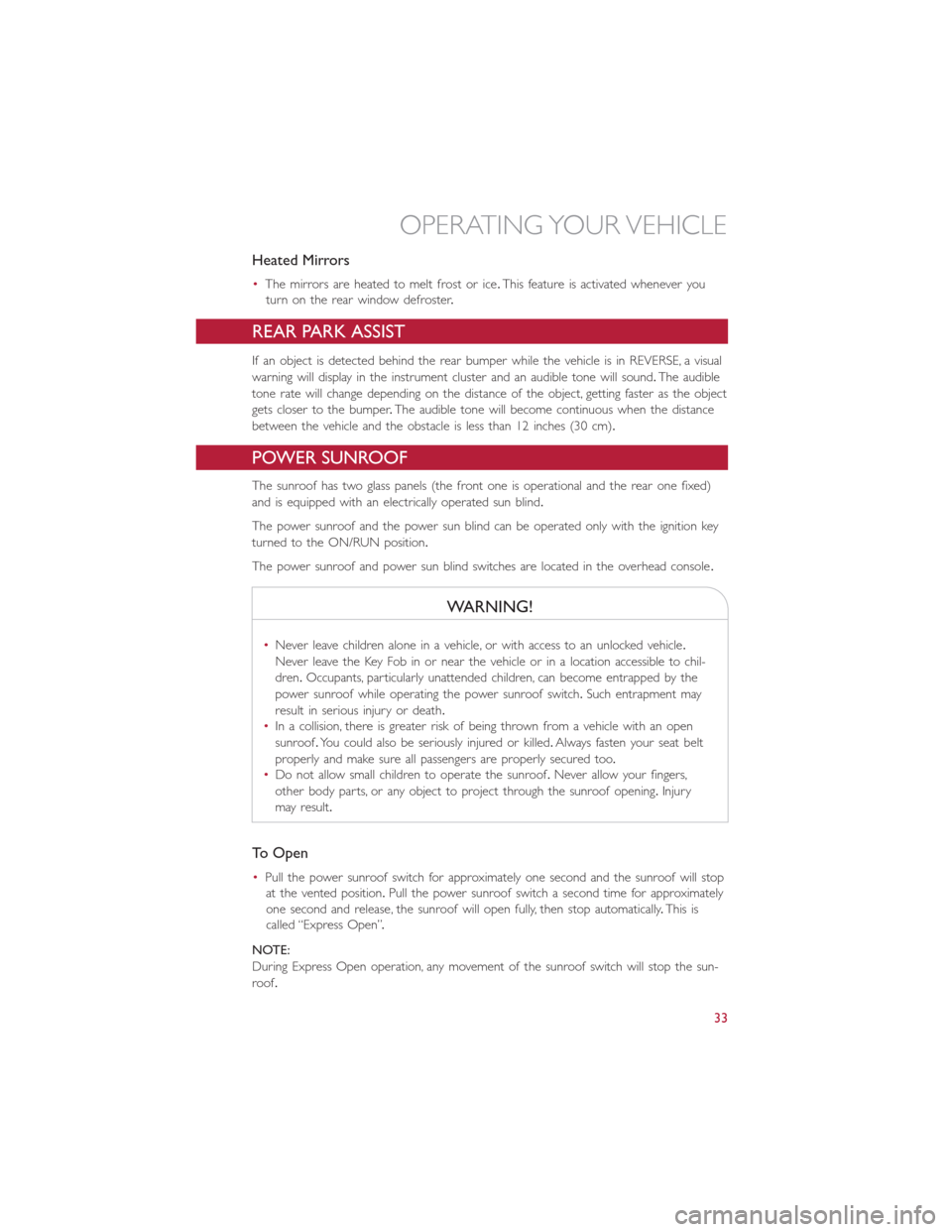
Heated Mirrors
•The mirrors are heated to melt frost or ice.This feature is activated whenever you
turn on the rear window defroster.
REAR PARK ASSIST
If an object is detected behind the rear bumper while the vehicle is in REVERSE, a visual
warning will display in the instrument cluster and an audible tone will sound.The audible
tone rate will change depending on the distance of the object, getting faster as the object
gets closer to the bumper.The audible tone will become continuous when the distance
between the vehicle and the obstacle is less than 12 inches (30 cm).
POWER SUNROOF
The sunroof has two glass panels (the front one is operational and the rear one fixed)
and is equipped with an electrically operated sun blind.
The power sunroof and the power sun blind can be operated only with the ignition key
turned to the ON/RUN position.
The power sunroof and power sun blind switches are located in the overhead console.
WARNING!
•Never leave children alone in a vehicle, or with access to an unlocked vehicle.
Never leave the Key Fob in or near the vehicle or in a location accessible to chil-
dren.Occupants, particularly unattended children, can become entrapped by the
power sunroof while operating the power sunroof switch.Such entrapment may
result in serious injury or death.
•In a collision, there is greater risk of being thrown from a vehicle with an open
sunroof.You could also be seriously injured or killed.Always fasten your seat belt
properly and make sure all passengers are properly secured too.
•Do not allow small children to operate the sunroof.Never allow your fingers,
other body parts, or any object to project through the sunroof opening.Injury
may result.
To Open
•Pull the power sunroof switch for approximately one second and the sunroof will stop
at the vented position.Pull the power sunroof switch a second time for approximately
one second and release, the sunroof will open fully, then stop automatically.This is
called “Express Open”.
NOTE:
During Express Open operation, any movement of the sunroof switch will stop the sun-
roof.
OPERATING YOUR VEHICLE
33
Page 36 of 148
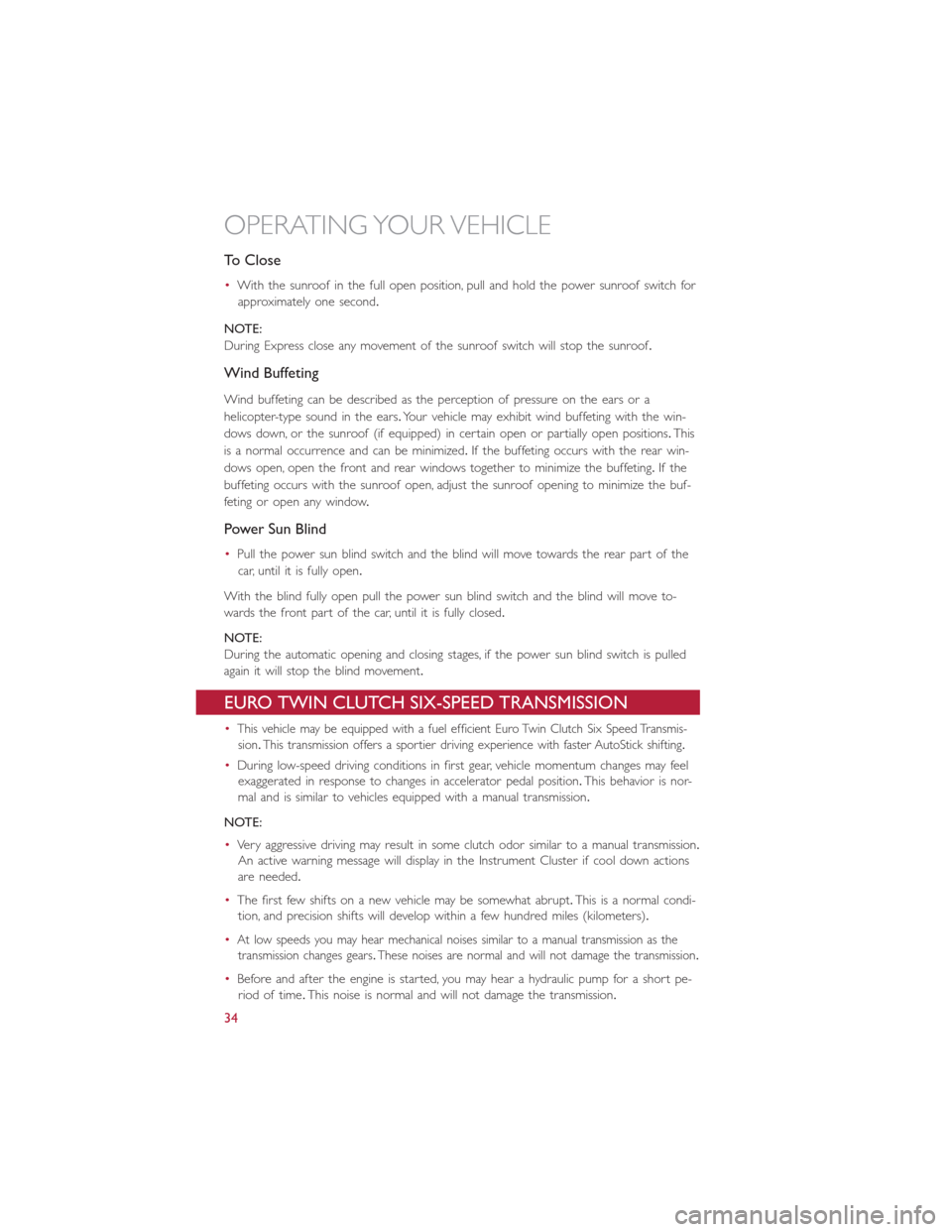
To Close
•With the sunroof in the full open position, pull and hold the power sunroof switch for
approximately one second.
NOTE:
During Express close any movement of the sunroof switch will stop the sunroof.
Wind Buffeting
Wind buffeting can be described as the perception of pressure on the ears or a
helicopter-type sound in the ears.Your vehicle may exhibit wind buffeting with the win-
dows down, or the sunroof (if equipped) in certain open or partially open positions.This
is a normal occurrence and can be minimized.If the buffeting occurs with the rear win-
dows open, open the front and rear windows together to minimize the buffeting.If the
buffeting occurs with the sunroof open, adjust the sunroof opening to minimize the buf-
feting or open any window.
Power Sun Blind
•Pull the power sun blind switch and the blind will move towards the rear part of the
car, until it is fully open.
With the blind fully open pull the power sun blind switch and the blind will move to-
wards the front part of the car, until it is fully closed.
NOTE:
During the automatic opening and closing stages, if the power sun blind switch is pulled
again it will stop the blind movement.
EURO TWIN CLUTCH SIX-SPEED TRANSMISSION
•This vehicle may be equipped with a fuel efficient Euro Twin Clutch Six Speed Transmis-
sion.This transmission offers a sportier driving experience with faster AutoStick shifting.
•During low-speed driving conditions in first gear, vehicle momentum changes may feel
exaggerated in response to changes in accelerator pedal position.This behavior is nor-
mal and is similar to vehicles equipped with a manual transmission.
NOTE:
•Very aggressive driving may result in some clutch odor similar to a manual transmission.
An active warning message will display in the Instrument Cluster if cool down actions
are needed.
•The first few shifts on a new vehicle may be somewhat abrupt.This is a normal condi-
tion, and precision shifts will develop within a few hundred miles (kilometers).
•At low speeds you may hear mechanical noises similar to a manual transmission as the
transmission changes gears.These noises are normal and will not damage the transmission.
•Before and after the engine is started, you may hear a hydraulic pump for a short pe-
riod of time.This noise is normal and will not damage the transmission.
OPERATING YOUR VEHICLE
34
Page 37 of 148
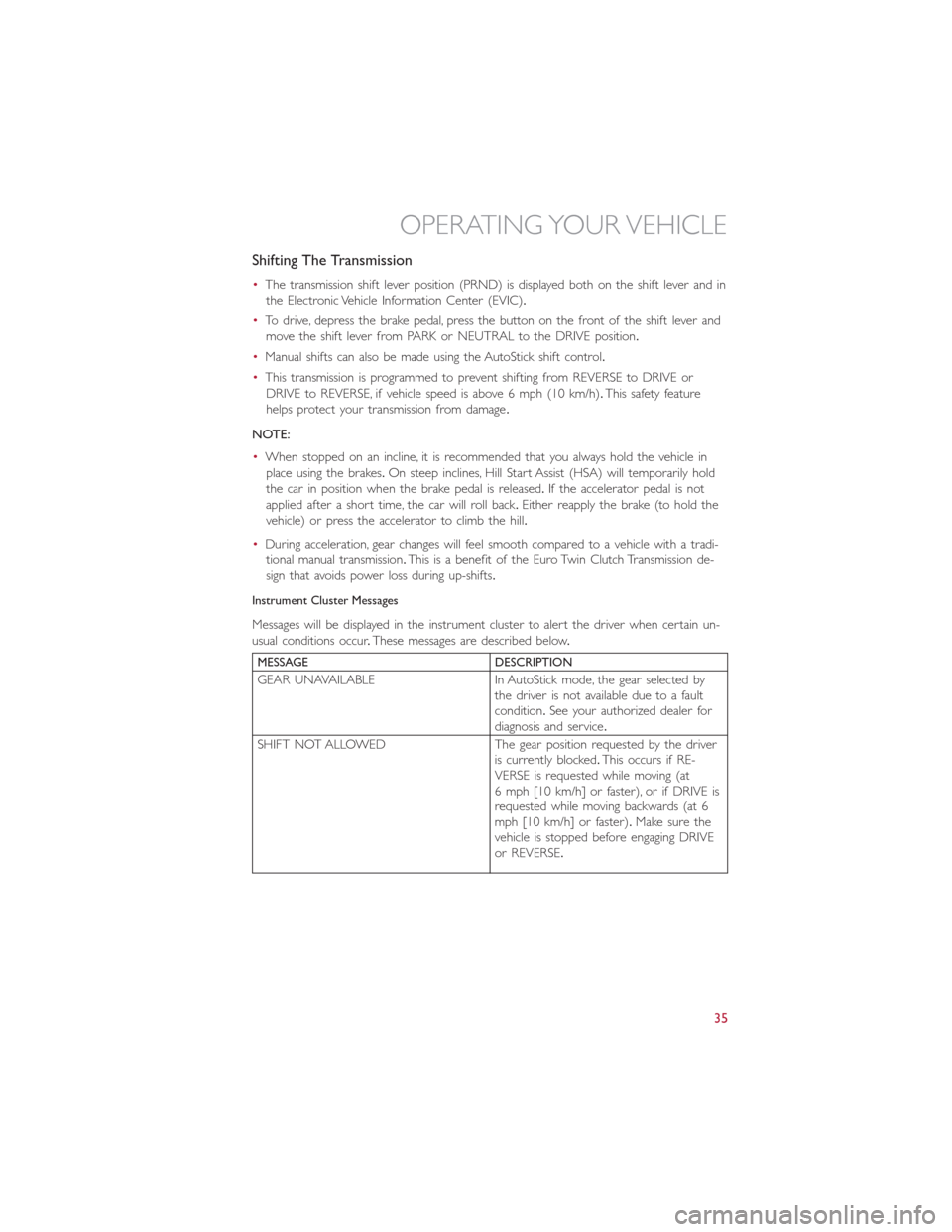
Shifting The Transmission
•The transmission shift lever position (PRND) is displayed both on the shift lever and in
the Electronic Vehicle Information Center (EVIC).
•To drive, depress the brake pedal, press the button on the front of the shift lever and
move the shift lever from PARK or NEUTRAL to the DRIVE position.
•Manual shifts can also be made using the AutoStick shift control.
•This transmission is programmed to prevent shifting from REVERSE to DRIVE or
DRIVE to REVERSE, if vehicle speed is above 6 mph (10 km/h).This safety feature
helps protect your transmission from damage.
NOTE:
•When stopped on an incline, it is recommended that you always hold the vehicle in
place using the brakes.On steep inclines, Hill Start Assist (HSA) will temporarily hold
the car in position when the brake pedal is released.If the accelerator pedal is not
applied after a short time, the car will roll back.Either reapply the brake (to hold the
vehicle) or press the accelerator to climb the hill.
•During acceleration, gear changes will feel smooth compared to a vehicle with a tradi-
tional manual transmission.This is a benefit of the Euro Twin Clutch Transmission de-
sign that avoids power loss during up-shifts.
Instrument Cluster Messages
Messages will be displayed in the instrument cluster to alert the driver when certain un-
usual conditions occur.These messages are described below.
MESSAGE DESCRIPTION
GEAR UNAVAILABLE In AutoStick mode, the gear selected bythe driver is not available due to a faultcondition.See your authorized dealer fordiagnosis and service.
SHIFT NOT ALLOWED The gear position requested by the driveris currently blocked.This occurs if RE-VERSE is requested while moving (at6 mph [10 km/h] or faster), or if DRIVE isrequested while moving backwards (at 6mph [10 km/h] or faster).Make sure thevehicle is stopped before engaging DRIVEor REVERSE.
OPERATING YOUR VEHICLE
35
Page 38 of 148

MESSAGE DESCRIPTION
SHIFT TO NEUTRAL – THEN DRIVE ORREVERSEThe transmission has shifted itself intoNEUTRAL (due to a fault condition, oroverheat due to excessive idling whenstopped in DRIVE with the brakes re-leased), but the shift lever remains in gear.Shift into NEUTRAL and then back intogear for continued driving.If the transmis-sion will not re-engage, see your autho-rized dealer.
AUTOMATIC UNAVAILABLE The transmission is unable to shift itselfautomatically, due to a fault condition.Usethe AutoStick mode to shift the transmis-sion manually.See your authorized dealerfor diagnosis and service.
REDUCE GEAR CHANGES The transmission pump is overheating.InAutoStick mode, try to drive in one spe-cific gear as much as possible, avoiding fre-quent gear changes.In DRIVE, the trans-mission will automatically modify its shiftschedule to reduce the number of shifts.
TRANSMISSION GETTING HOT PRESSBRAKEThe transmission driving clutch is overheat-ing, usually due to repeated launches instop-and-go traffic.Pull over and allow thetransmission to cool in NEUTRAL until“TRANS.COOL READY TO DRIVE” isdisplayed.
TRANS.HOT STOP SAFELY SHIFT TOPARK WAIT TO COOLThe transmission driving clutch has over-heated.Pull over, shift the transmission intoPARK, and allow the vehicle to cool until“TRANS.COOL READY TO DRIVE” isdisplayed.
TRANSMISSION COOL READY TODRIVEThe transmission has cooled down and thevehicle is OK to drive.
SERVICE TRANSMISSION A transmission fault has been detected.See your authorized dealer for diagnosisand service.
SERVICE A shift lever fault has been detected.Seeyour authorized dealer for diagnosis andservice.
SET PARK BRAKE The sensor that confirms PARK engage-ment is not functioning properly.Engagethe parking brake to ensure that the ve-hicle will not roll when in PARK.
OPERATING YOUR VEHICLE
36
Page 39 of 148
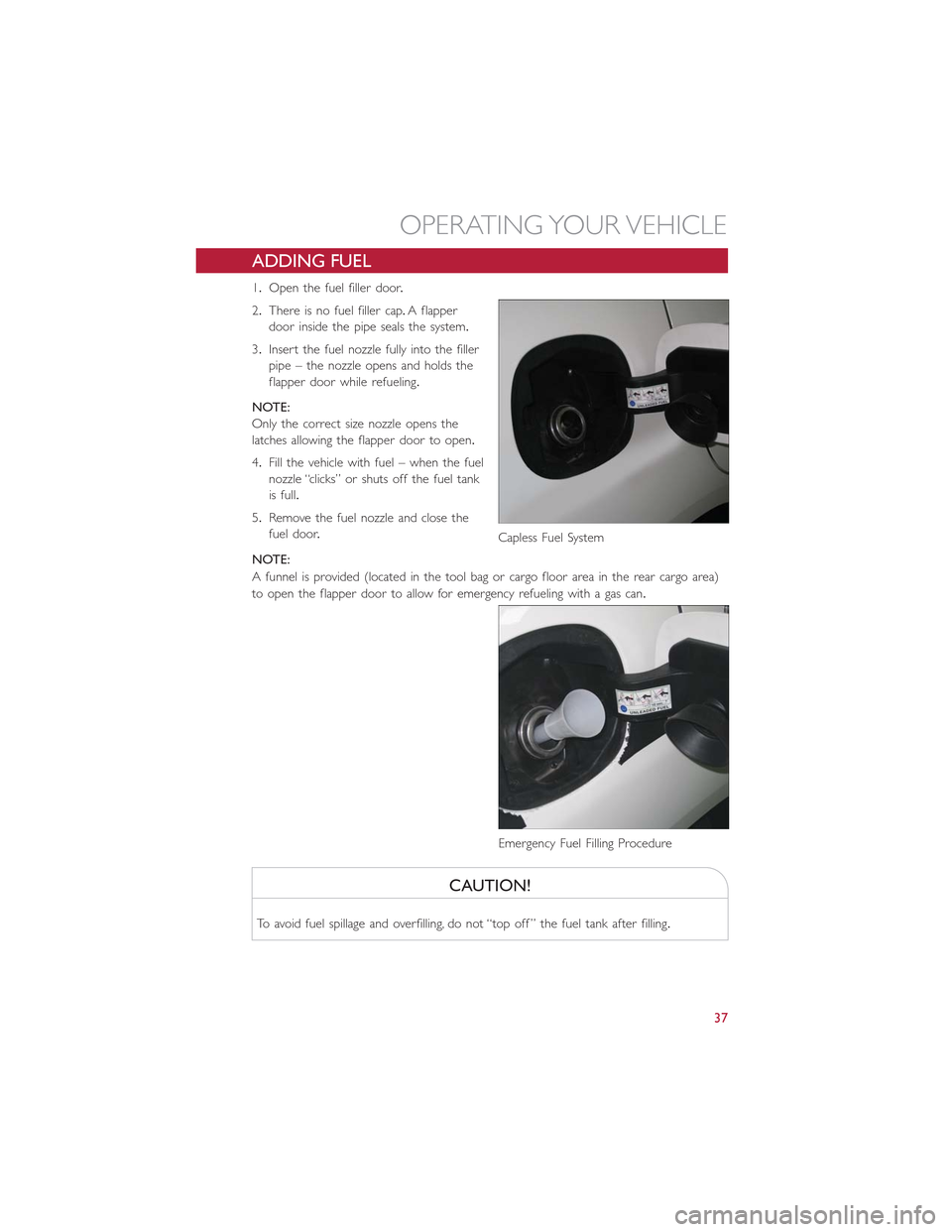
ADDING FUEL
1.Open the fuel filler door.
2.There is no fuel filler cap.A flapper
door inside the pipe seals the system.
3.Insert the fuel nozzle fully into the filler
pipe – the nozzle opens and holds the
flapper door while refueling.
NOTE:
Only the correct size nozzle opens the
latches allowing the flapper door to open.
4.Fill the vehicle with fuel – when the fuel
nozzle “clicks” or shuts off the fuel tank
is full.
5.Remove the fuel nozzle and close the
fuel door.
NOTE:
A funnel is provided (located in the tool bag or cargo floor area in the rear cargo area)
to open the flapper door to allow for emergency refueling with a gas can.
CAUTION!
To avoid fuel spillage and overfilling, do not “top off ” the fuel tank after filling.
Capless Fuel System
Emergency Fuel Filling Procedure
OPERATING YOUR VEHICLE
37
Page 40 of 148
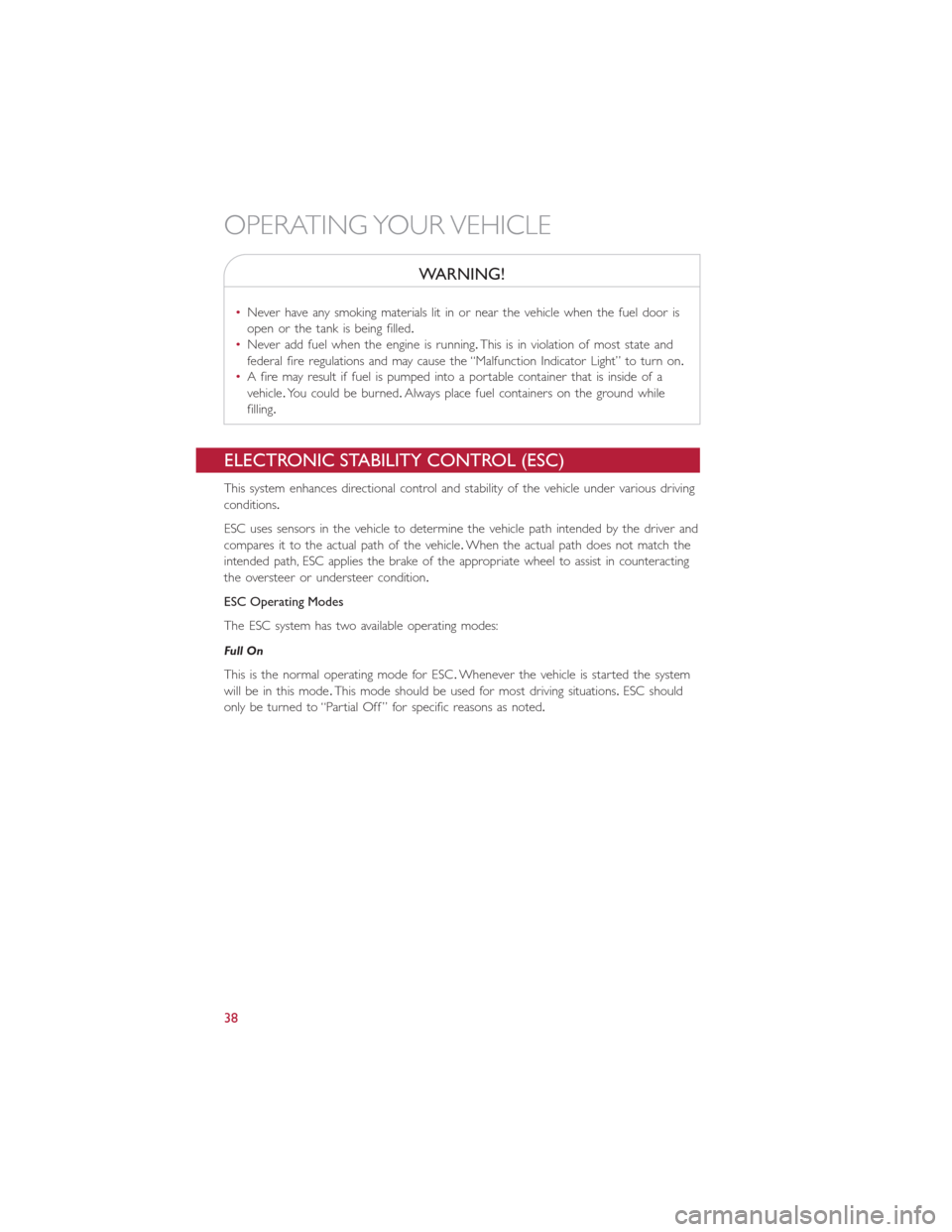
WARNING!
•Never have any smoking materials lit in or near the vehicle when the fuel door is
open or the tank is being filled.
•Never add fuel when the engine is running.This is in violation of most state and
federal fire regulations and may cause the “Malfunction Indicator Light” to turn on.
•A fire may result if fuel is pumped into a portable container that is inside of a
vehicle.You could be burned.Always place fuel containers on the ground while
filling.
ELECTRONIC STABILITY CONTROL (ESC)
This system enhances directional control and stability of the vehicle under various driving
conditions.
ESC uses sensors in the vehicle to determine the vehicle path intended by the driver and
compares it to the actual path of the vehicle.When the actual path does not match the
intended path, ESC applies the brake of the appropriate wheel to assist in counteracting
the oversteer or understeer condition.
ESC Operating Modes
The ESC system has two available operating modes:
Full On
This is the normal operating mode for ESC.Whenever the vehicle is started the system
will be in this mode.This mode should be used for most driving situations.ESC should
only be turned to “Partial Off ” for specific reasons as noted.
OPERATING YOUR VEHICLE
38